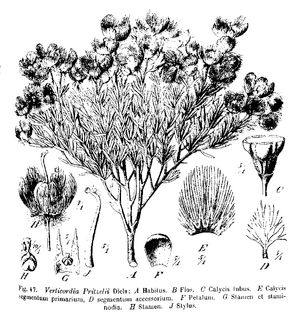Pritzel's featherflower facts for kids
Quick facts for kids Pritzel's featherflower |
|
|---|---|
 |
|
| Illustration from the species first description | |
| Scientific classification | |
| Genus: |
Verticordia
|
| Species: |
pritzelii
|
Verticordia pritzelii, also known as Pritzel's featherflower, is a beautiful flowering plant. It belongs to the myrtle family, called Myrtaceae. This special plant only grows in the south-west part of Western Australia. It's a small, woody bush with many stems. It has tiny leaves and pretty deep pink flowers. These flowers bloom from late spring to mid-summer.
Contents
What Does Pritzel's Featherflower Look Like?
Pritzel's featherflower is a shrub that usually grows to be about 15–90 cm (6–40 in) tall. It can also spread out to 15–70 cm (6–30 in) wide. It has several main stems coming from its base.
The leaves are shaped like lines or small clubs. They are semi-circular if you cut them in half. Each leaf is about 2–8 mm (0.08–0.3 in) long and has a tiny point at the end.
The flowers have a lovely scent. They grow in round groups, and each flower sits on a small stalk about 5–6 mm (0.20–0.24 in) long. The part that holds the flower, called the floral cup, is shaped like half a ball. It's about 1.5 mm (0.06 in) long.
The sepals are like small leaves that protect the flower bud. They spread out and are deep pink when new, but turn white as they get older. They are about 4.5–6 mm (0.18–0.24 in) long. Each sepal has 4 to 6 long, thin parts and two fuzzy bits. The petals are the same deep pink color as the sepals. They are about 2.5 mm (0.1 in) long and stand upright. They are mostly round with tiny teeth along their edges. The style, which is part of the flower's reproductive system, is about 5–5.5 mm (0.20–0.22 in) long. It has small hairs near its tip. This plant flowers from October to early January.
The bright pink color of its flowers and its bushy shape help tell V. pritzelii apart. It looks different from other plants in its group, called section Catocalypta.
How Did It Get Its Name?
The first official description of Verticordia pritzelii was made by a scientist named Ludwig Diels. He described it in 1904. He found a sample of the plant near Coolgardie. His description was published in a book called Fragmenta Phytographiae Australiae occidentalis.
The second part of its name, pritzelii, was given to honor Ernst Georg Pritzel. He was a friend who visited Diels in 1900.
Later, in 1991, another scientist named Alex George studied the Verticordia group of plants. He placed Pritzel's featherflower into a specific subgroup. This subgroup is called subgenus Verticordia, section Catocalypta. Other plants in this group include V. inclusa and V. insignis.
Where Does It Grow?
Pritzel's featherflower grows in sandy areas. The sand can be yellow, white, or grey. You can find it on rolling plains in several regions of Western Australia. These regions include the Avon Wheatbelt, Coolgardie, Mallee, Murchison, and Swan Coastal Plain. Some towns near where it grows are Perenjori and Forrestania.
Is It Endangered?
Good news! The Western Australian Government's Department of Parks and Wildlife says that Verticordia pritzelii is "not threatened." This means there are enough of these plants in the wild, and they are not in danger of disappearing.
Can You Grow It in a Garden?
This plant could be a good choice for gardens. It's fairly easy to start growing new plants from its seeds or cuttings. However, it can be tricky to keep it alive in a garden for a long time. Even so, it was once grown successfully in the Kings Park Botanical Garden.

